So Briefly An Eagle: A Memorial Day Remembrance
So Briefly An Eagle
This memoir is based on letters and telephone conversations with Messrs. Frank Zywiczynski and Jerry Evers, and on research done by the writer in the USAF Archives. Mr. Evers, an airline flight attendant, had the opportunity to interview French citizens who had witnessed this incident. With the advent of Internet it was possible to gather factual data from several veterans of the U.S. Eighth Army Air Corps The content of this remembrance is factual. Editing has been done only for continuity and readability.
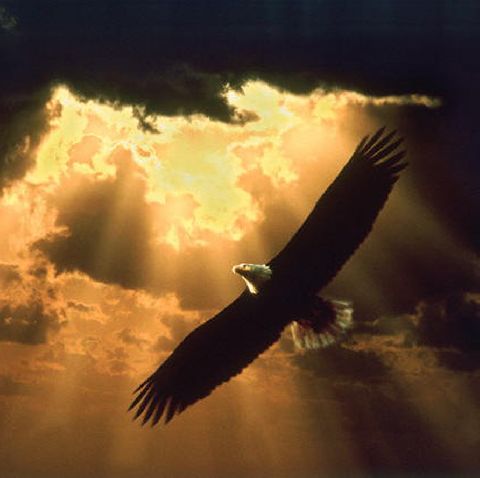

April 1. “April Fools’ Day.” A day for practical jokes, hi-jinks and general silliness. A day for fun. But on this April Fools Day” in the year 1944 it was no practical joke when the CQ (Charge of Quarters) awakened Technical Sgt. Raymond R. “Rudy” Carriker at 4:00 a.m. from his sound sleep in a drafty, “Nissen” hut in East Anglia, GB. The CQ went on to awaken scores of other young men in other huts. Amidst the general complaining common to young men in the army they threw back their blankets, pulled on a clean pair of “long handles” and crunched over a gravel walk to the latrine to wash their faces in the never-warm water. It was a miserably damp, cold morning – typical of the weather in this part of England in the spring. Low clouds frustrated the stars and moon in their efforts to provide beauty and light to the young men’s comings and goings.
This ritual was being performed in Army Air Corps bases all across East Anglia this early morning. Today hundreds of young men would leave their clean, warm beds, put on clean clothes, enjoy a sumptuous hot breakfast and spend most of the day inside a bomber, breathing stale, sweat bathed oxgyen through a cloying rubber mask while doing their best to stay alive on the most lethal of all battlegrounds of World War II – the skies over Nazi-occupied Europe. Those who survived would return at the end of the day to their clean, comfortable night-time life.
It was a schizophrenic kind of existence, totally different from the 24/7 filthy living conditions, bad food and constant terror faced by an infantryman. Did the infantryman become numb to his animal-like living because there was no respite from it? Maybe, maybe not. But the bomber crewmen of the 8th Army Air Corps had to reconcile their mind to living on an emotional pendulum that swung almost daily from stark terror 30,000 feet above the ground to a pleasant life on the ground where they enjoyed hot food, movies and regular dances with friendly English girls to dance with and woo.
Can “Which was the worst kind of life” be answered? Not definitively. The infantrymen of WWII were said to envy the Air Corps warriors but neither they nor the airmen knew that when all the figures were tallied at the end of the war historians would record that the 8th Army Air Corps suffered more casualties in percentage terms than any other military unit that fought in that war. The skies over Europe were killing field for hundreds of thousands of young men on both sides – a deadly battlefield where no bloody evidence remains and no monuments stand.
On this “April Fools’ Day” hundreds of planes, B-17 “Flying Fortresses” and B-24 “Liberators” were being sent from various air bases to destroy an important rail center and shipping point in Ludwigshafen, Germany. After breakfast and a briefing T/Sgt. Carriker and scores of young men climbed into their planes and prepared for battle. They were dressed in heavy fur-lined jackets over electrically heated boots and flying suits, for one of death’s fingers that reached for them was the bitter cold wind that swept through their unsealed aircraft in the high-altitude sub-zero sky. It was not unusual for airmen to freeze to death as a result of the failure of an electrically heated suit.
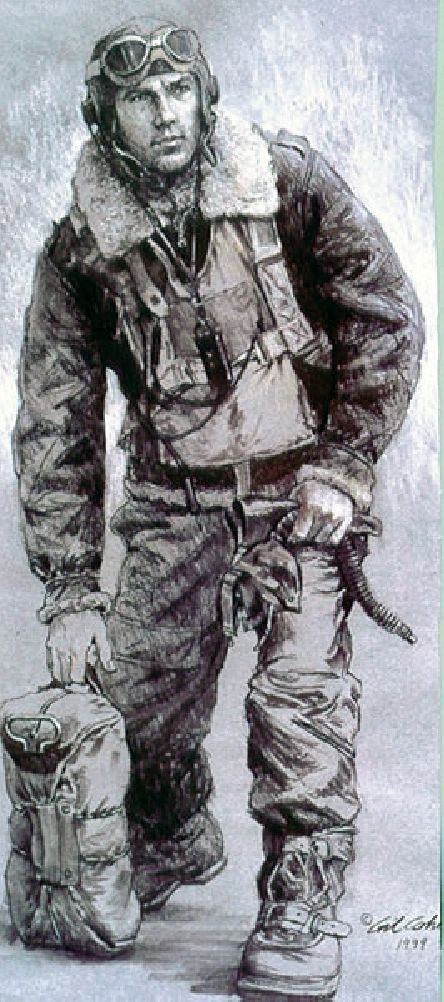
A Gunner, Dressed for Battle
The crew to which T/Sgt. Carriker belonged was a collage of the face of 1940’s America. Their pilot, Lt. Ed. Robbins, was from a small town in Missouri, his co-pilot, Lt. James Wagner; from Pennsylvania, Lt. Robert Bins, navigator, claimed Wisconsin as his home, while the bombardier, Lt. Joseph McCauley, represented that American place made famous by the raucous cheer of its baseball fans, “The Bronx.” The Enlisted Men, in addition to Carriker, the flight engineer/top turret gunner, who was proud to be an “Okie” from Oklahoma, were T/Sgt. Jack McAllen, radioman and a Pennsylvania citizen, S/Sgt Frank Zywiczynski, who manned the left waist gun was from Toledo, Ohio. The remaining Enlisted Men who completed the collage of the face of America were S/Sgt David Butler, a Texan, S/Sgt Charles Speier, from Minneapolis and S/Sgt. Stanley Wojciechowski from Cleveland OH. But on this morning of April 1, 1944 they called the Army Air Corps base at Hardwicke, England home. In the air, where they spent so many of their waking hours, “home” was a pugnacious looking bomber with the name “Bar Fly” painted on its nose.
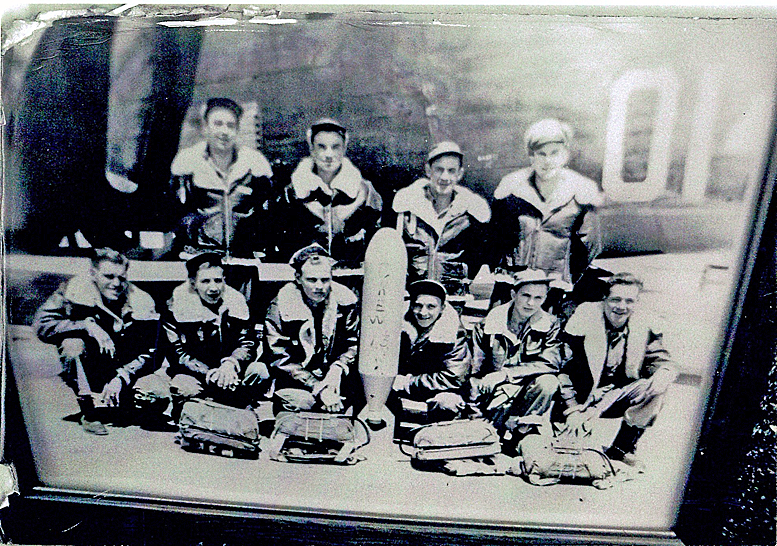
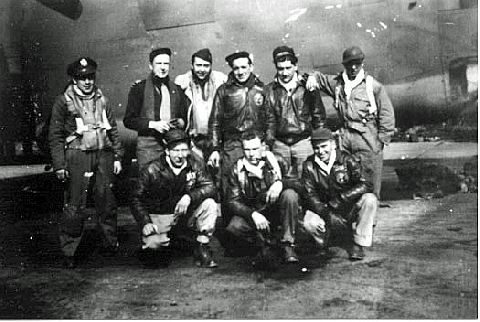
The Robbins Crew upon completion of their "stateside" training (top)
and
After an unknown number of missions
Although the B-17 “Flying Fortress” got most of the attention and glory from the media the B-24 “Liberator” could fly higher, faster, farther and carry more bombs than that beauty queen of the sky. The Liberator was beautiful in a rugged, “Mack Truck” sort of way. The German pilots called it a “Flying Boxcar.” But it had a fatal flaw in its design. Its creators had routed fuel lines in such a way as to pass through the fuselage. A B-24 in flight smelled like a fuel truck. It was terribly prone to in-flight fires and/or explosions.
Within seconds after take-off the “Bar Fly” and its sister ships from Hardwicke disappeared into the low hovering clouds. The crews feared this part of their “job” almost as much as combat. The bombers left the runway at 30 second intervals. Once in the clouds there was no way of knowing where other bombers were. They knew only that they were mere seconds away from a mid-air collision. Survival depended upon each pilot keeping his plane exactly where it was supposed to be at precisely a given speed. All too often there would be a bright flash in the clouds, a sudden explosion; and pieces of two bombers crashing to the ground - usually killing all aboard. That didn’t happen this day though. All the bombers broke out of the clouds and after spending a half hour or so assembling into a huge attack formation they headed for their target.
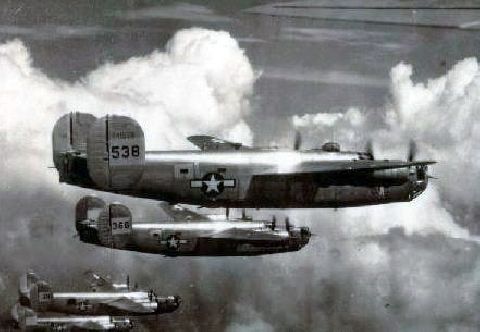

Bombers in battle formation (top) and "The Bar Fly" (bottom)
Preparing for take-off in England
While assembling, Lt. Robbins had the crew check their flying suits and oxygen supply and report to him over the intercom. A failure of either one would cause him to abort the mission for the “Bar Fly.” This morning all was well and everyone except the pilots could relax for a few minutes. When the English Channel slid under their wings Robbins told the gunners to check their guns. For the next several seconds the plane would shudder and was filled with noise as all eight of its .50 caliber machine guns chattered.
In the briefing the men had been told the skies over their route would be clear of clouds. That forecast was soon proven wrong. The huge formation was in and out of clouds. Flying wingtip to wingtip as they were required to do, this created a dangerous situation. Shunning this danger the B-17’s group leader ordered his squadron to return to its base. The commander of the Liberators disagreed. The Liberators continued on toward their target. His arguable error in judgment soon became apparent. Elements of the B-24 squadrons lost contact with one another – they now proceeded in three separate, much smaller formation. The April 1 mission was becoming an April Fools fiasco for which a high-ranking officer was later reprimanded and relieved of command. The operation became such a debacle that one of the groups, blown far off course by the wind, mistakenly bombed a town in Switzerland; prompting an international crisis.
When the strike force reached Ludwigshafen the Group Commander decided there was too much cloud cover to bomb successfully. He ordered the group to continue on to their secondary target – Strasbourg. S/Sgt. Frank Zywiczynski, left waist gunner on the “Bar Fly” strongly disagreed with the Group Commander’s assessment of the weather. In a letter written after the war he said he could see the target clearly. It didn’t matter. Orders were to be followed.
What did matter was that the anti-aircraft gunners on the ground zeroed in on “Bar Fly” and scored a direct hit. From this point on the mission is best described in the exact words of S/Sgt. Zywiczynski.
“Flak near Ludwigshaven damaged the vertical and horizontal tail and the inboard right engine and was the cause of an oxygen fire near the waist right side. Rudy and I made repairs, surveyed the damage to the tail section and viewed the engine from the waist. He (Rudy) then returned forward and I assume assisted the pilots and Jack, the radio operator, took his place in the upper turret. We lost altitude and ability to keep up with the formation. The flying time to Strasbourg I would guess to be about two hours. We dropped our ordinance on Strasbourg, near the German/French border. (After) about an hour-plus flying time we neared Rheims, France. Here I saw and reported taking off in a formation of four abreast and five lines of probably enemy aircraft. They climbed to our level of altitude but out of firing range, flying from the front (of our plane) to past 9:00 o’clock to 6:00 o’clock in a bank turn for a tail attack from slightly below. In that first wave Butler, firing the other waist gun, was hit fatally. When they passed under I seen (sic) F.W.190 radial yellow nose and milk white ME 109’s. They repeated the first pattern for a second attack at our tail. This time multi-cannon fire took out the tail turret that Stanley (Wojciechowski) was in. His wounds were definitely fatal.”
There was a third attack during which time S/Sgt. Zywiczynski said he heard the top turret firing in short bursts.
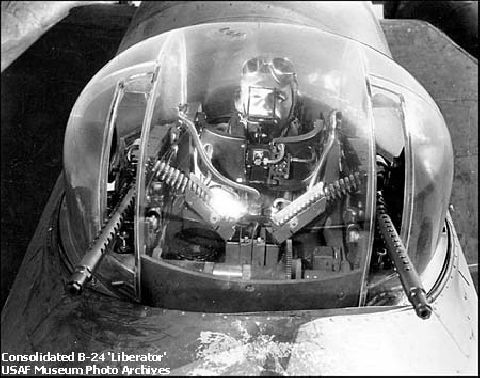
Top Gun Turret on a B-24 "Liberator"
From that point he doesn’t know for sure what happened. He believed the “Bar Fly," filled with avgas fumes, exploded. The blast stunned him and blasted him outside into the empty sky. He “came to” falling in mid-air long enough to pull the ripcord on his parachute after which he blacked-out again
What was left of the twin-ruddered tail section hit the earth last. The reverberation of its final destructive impact echoing the terrible sound made seconds earlier when the main body, a mass of flame, had crashed heavily into the ground The tail had come spiraling down like a dry oak seed to burrow into the earth only yards from the charnel of what had been only moments before the fuselage of a B-24. In the tail-gunner’s turret, between the characteristic elephant ears of the Liberator’s rudders, what was left of a human body that had absorbed the full and direct impact of a 20-millimeter cannon shell, lay scarcely recognizable; the remains of a young man. Half a minute later and several yards away from the wreckage the silk canopy of a parachute wilted and collapsed over the quiet form of another young man. He lay silent and unmoving; his parachute a shroud over his body.
After that the only sound was the crackling of flames as they consumed aluminum, wiring, fluids, and the flesh and blood of the eight young men who had fallen with it. There were, mercifully, no anguished cries for help, no pleas to God. The time for that had passed.
As for the living: no matter how compassionate they might be there was nothing to be done except wait for the flames to finish digesting their fuel. When German soldiers arrived on the scene they discovered life in the body beneath the parachute. It was S/Sgt. Zywicynski. They him to a hospital where he recuperated until being imprisoned in a German P.O.W. camp where he stayed until the end of the war.
Many hours later, after the fire completed its work and fresh spring air had cooled the blackened, twisted metal, the full horror of aerial war was revealed. Recognizable as human forms only by their crushed and burned remains, the men who had lived together, flown together, and fought together now in a display of the blackest possible irony lay dead together; tangled in a near-indistinguishable mass of bone and burned flesh. The flames had completed the work started by the brutal impact.
Unable to distinguish identities; the bodies were consigned to a common grave in a community cemetery in Bourgogne, France. Perhaps a devout Christian said a prayer; perhaps not. It was war and they were the enemy lying in enemy soil.
Coffeyville Army Air Base
Coffeyville, Kansas
1945
Shortly after the end of World War II, Jack and Shug Carriker were invited to the nearby Coffeyville Army Air Base to receive their son’s Purple Heart and Air Medal with Three Oak Leaf Clusters posthumously.
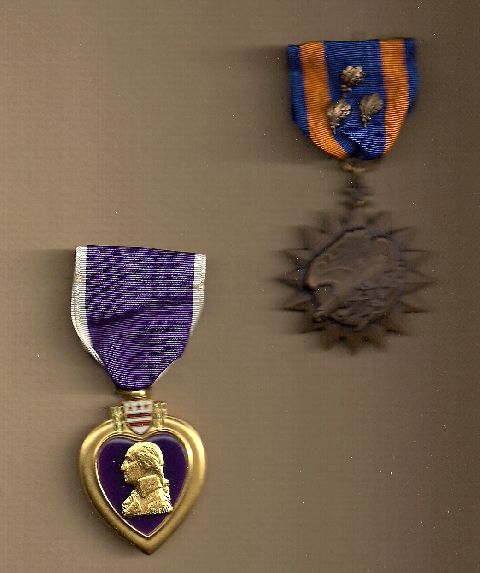
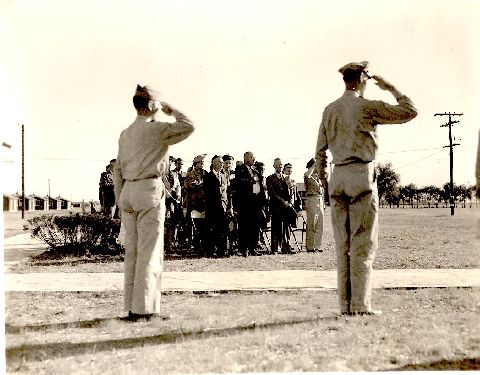
The ceremony was conducted with full and appropriate military honors and pageantry. The flag was lowered to half mast, a bugler sounded “To the Colors,” and the parents were called to the front, where the Base Commander read the citation that accompanied their son’s medals.
After accepting those medals on his behalf and receiving a crisp, respectful military salute from the Commander, Jack and Shug watched and listened as the bugler sounded “Retreat” while the colors were raised to the top of the flagpole and then lowered with fitting gravity. It was a terrible, unwanted, proud moment
Ft. Gibson National Veterans Cemetery
Ft. Gibson, Oklahoma
October, 1949
On October 13, 1949, at 1630 hours Military Time a train carrying a bronze casket in which lay what remained of the body of T/Sgt. Ray R. Carriker, ASN 38318506 arrived at the train station in Muskogee, Oklahoma. It was escorted by M/Sgt. Charles E. Jackson, who, in accordance with military custom accorded all fallen warriors, had guarded it on its long cross-country trip from New York City. Years later, while researching official Air Force files, documents were found. They showed that inside that casket there were a pitfully few bones. Complete skeletons of the crew members did not exist. DNA did not exist, so there was no accurate way of knowing. . . It would have made no difference at the time.
On the following day, a beautiful autumn day at Ft. Gibson National Cemetery, Jack, Shug, and two of their remaining sons stood silently at the graveside of their son and brother as the flag-covered casket rested on web straps that would lower it into a final grave. This time it was into the soil Rudy called home. He was back in Oklahoma. The brief sermon, by Mr. (“Brother”) B. F. Pollard, an RLDS “Elder” who had baptized Rudy as a young boy, was over. There was little the preacher could say to validate the loss. Only prayer remained.
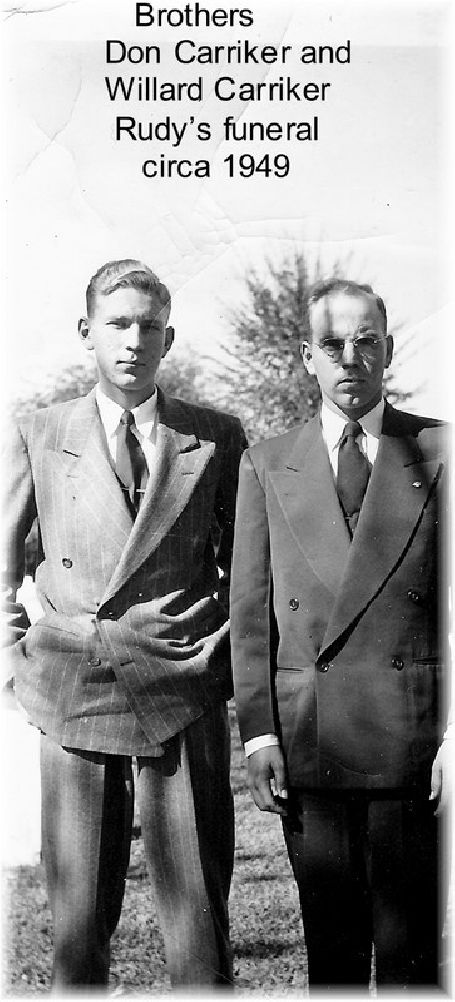
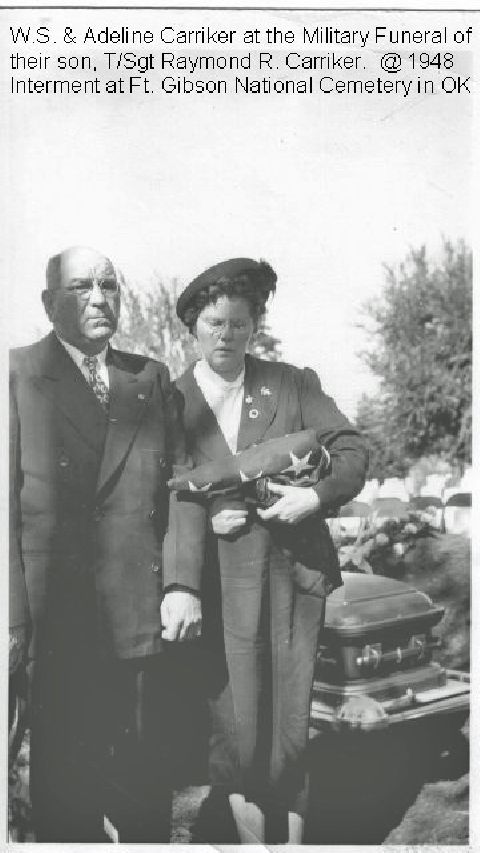
Don and Willard Carriker Top Photo)
W.S. and Adeline (Shug) Carriker(Bottom Photo)
The flag that had been draped over the casket was solemnly and ritualistically folded and presented to a tearful Shug. It was a gift no mother would ever covet.While Jack stood beside her showing similar, slightly more restrained grief, seven rifles fired three volleys over the grave in the 21 Gun Salute given to America’s fallen warriors. When the last echo of those shots had faded the heart-wrenching sound of Taps washed over the silent gravestones. Raymond Rudolph Carriker’s body was laid to rest in Ft. Gibson National Cemetery. He was home.

The "Mission Airplane"

The "Nose Art"
About the author
Comments 10
Don, you have done a masterful job in documenting and capturing the details of this April 1st. The text and the photos together are amazing. Very well done!
Thank you for letting me know that I succeeded to some extent in memorializing those men who flew the "Bar Fly." They deserve to be remembered.
This is brilliant writing, Don. The story was gripping in every respect and I think it was truly inspired. My humble gratitude for the opportunity to re-live a piece of history.
Thank you for sharing with me event that still has barbs in my heart. The crew of the "Bar Fly" was symbolic of so many thousands of good young men who gave their lives for our freedom. And I appreciate you kind comments as to the way their story was told. Whatever talents I have come from God through my parents.
WOW!! What a great piece of history! I am so happy others are able to enjoy such a powerful story. You are a great brother. This should be taught in schools.
I'm just honored that I can leave a bit of my brother in the minds of a few people. Thanks to all of you who read this for being one of those people. Perhaps you will think this is odd but I don't consider "Rudy" a hero. He was just an American doing what Americans of that time did in the way "Americans" did it. WWII was the last war for which America was whole.
Thank you for your story of the Bar Fly. James L. Wagner was my uncle, my Dad's oldest brother. My father was a young boy when his brother buzzed his grade school, waggling his wings as he flew off for the last time. He also remembers that Uncle Jim flew over his parents' house and dropped a package for his mother on the front lawn. This story will mean a lot to my father when I share it with him. We are blessed to have a woman in Epinal, France who has "adopted" my uncle's headstone and regularly places flower memorials at the grave site. A wonderful group of volunteers regularly remembers and honors the crew of the Bar Fly, as well as all our fallen heroes interred overseas.
A pleasure to hear from you Sharon. Other than Frank Z. and Jerry Evers, you are the first person who had a relative on the Bar Fly that has ever contacted me. Do you have ANY letters from your Uncle in which he wrote anything about their military life while in England? If you do I would be so appreciative if you would copy and share them with me. My brother NEVER wrote anything about their missions, their life on base, etc. Did you know you Uncle James had the nickname "Buzz?" From your comments I think I now know why. Was he a pilot before the war? Did he attend college? I would really enjoy it if you would email me with any such information you have about him. I've tried to "get to know" the crew and it has been very difficult. email me (if you care to) at xav8r@outlook.com. Thanks for reading and commenting.
Hi Millard, I'll heap on some praise too. You've now located the family of another crewmember.... SSgt. D.A. Butler, the waist gunner, was my great uncle, one of my grandmother's older brothers. His full name is Daniel Alexander (you note him as "David"), but he was known to family and friends as "D.A." He was just 24 when they were shot down, and he had no wife or children. So, we do our best to carry on his memory. Your story here helps. I've shared it with many in our family and we really appreciate your work. I've collected several photos and remembrances of him, and I recently learned that one of my second cousins has a trunk full of his militaria and letters that he'd written home. I haven't been able to track that down yet, but I'll be working on that soon. My Great Grandmother Butler actually had his remains brought home from France and reinterred in Tulia, Texas in 1951. I have several pictures of the funeral service and some from his time in service (although none of the Bar Fly crew). Let me know if you'd like to see any. Best, Jeff
Hello everyone, my name is Sébastien NICOLAS. I am French and I researched the crash of the B24 Bar Fly and Judith Lynn fell on April 1, 1944 . I am also at the initiative of the monument that is today in Bourgogne in the Marne in France.
I congratulate you for this beautiful page.Elle is very moving
I also wanted to inform you that a ceremonial will be held on April 6, 2024 at the monument honouring these brave airmen
Find below the invitation
Friendships
M. Nicolas HABARE M. Sébastien Nicolas Mayor of Bourgogne Fresne initiator of the project
We are pleased to invite you to the commemoration of the 80th anniversary of the fall of the two American bombers «Judith Lynn» and «Bar Fly» who fell for our freedom in 1944
Saturday 06 April 2024 at 09:00
at the city hall of Bourgogne Fresne
9:30 am: Ceremony at the monument of the two bombers
10:45 am: glass of friendship at the Médiathèque
At the end of this occasion, a film screening and a photo exhibition
will be presented at the Médiathèque
Answer requested before March 30, 2024




